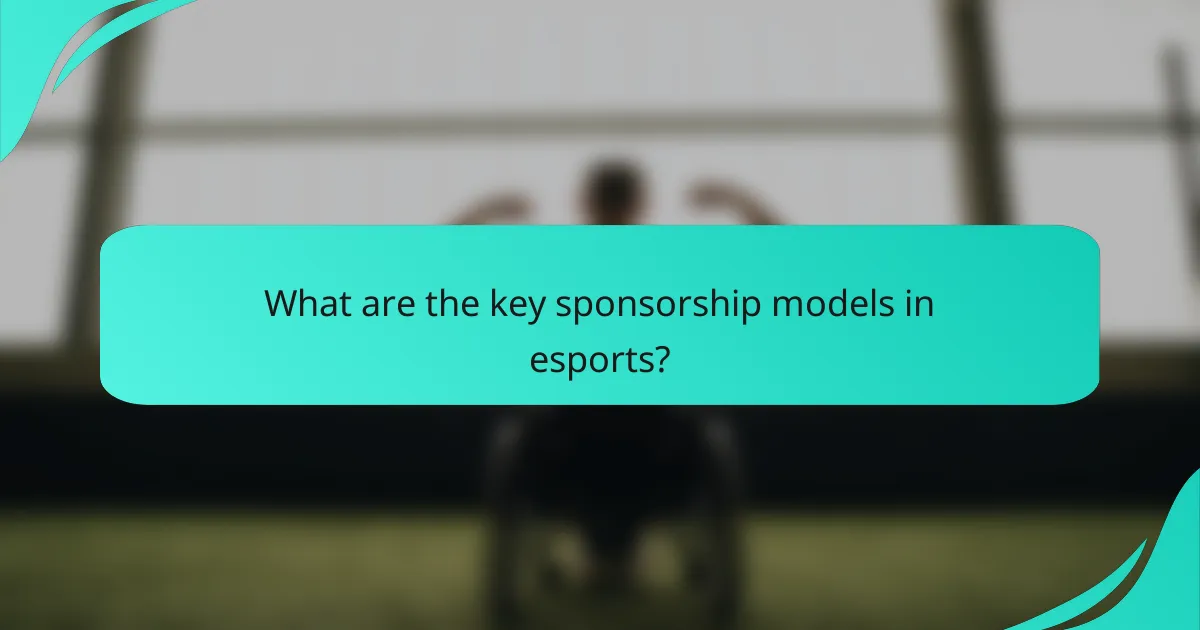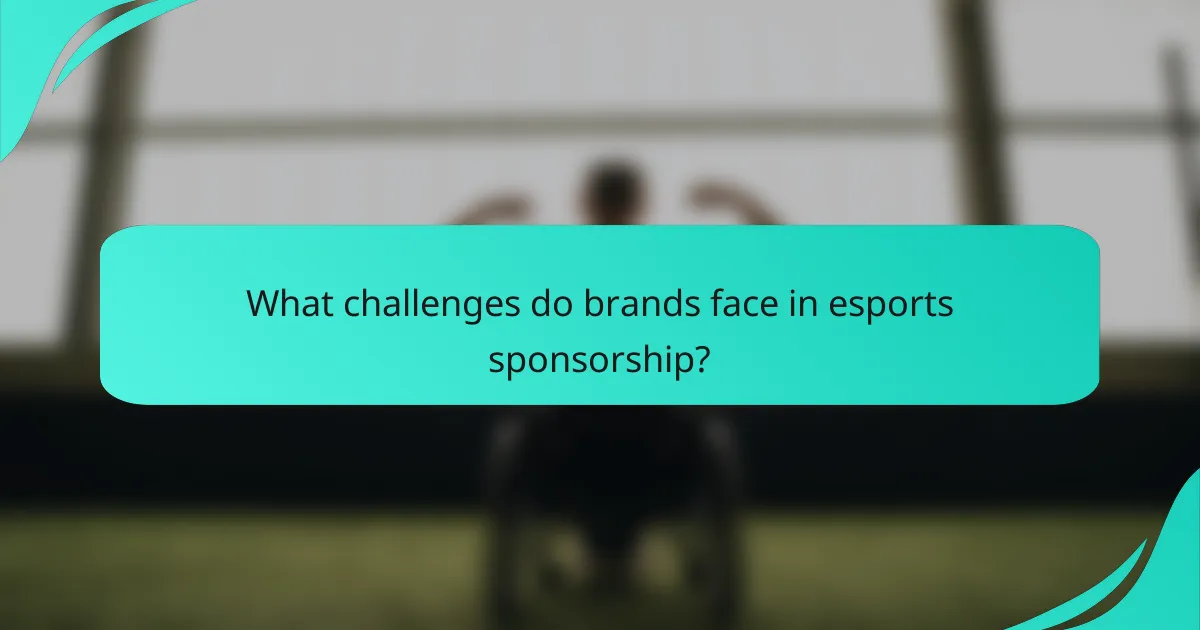Sponsorships have been instrumental in the evolution of esports, providing vital financial resources that have propelled teams and events into the mainstream. By enhancing visibility and legitimacy, these partnerships have attracted a broader audience and fostered rapid industry growth. Various sponsorship models, including team and event endorsements, offer brands unique opportunities to engage with the dynamic esports community.

How have sponsorships influenced esports growth in North America?
Sponsorships have played a crucial role in the growth of esports in North America by providing essential financial support and increasing visibility for teams and events. This influx of capital has enabled the industry to expand rapidly, attracting a wider audience and legitimizing esports as a mainstream entertainment option.
Increased funding for tournaments
Sponsorships have significantly boosted funding for esports tournaments, allowing organizers to offer larger prize pools and improve event production quality. Major sponsors often invest hundreds of thousands to millions of dollars, which can elevate the overall experience for players and fans alike.
This financial backing enables tournaments to secure better venues, advanced technology, and professional broadcasting, which enhances viewer engagement. For instance, events like the League of Legends Championship Series have seen prize pools reach several million dollars, largely due to sponsorship contributions.
Enhanced team visibility and branding
Sponsorships have improved team visibility by associating them with well-known brands, which helps in building a recognizable identity. Teams often display sponsor logos on their jerseys and during live streams, creating a direct connection between the brand and the audience.
This visibility can lead to increased fan engagement and loyalty, as supporters often feel a connection to both the team and its sponsors. For example, teams like Team Liquid and Cloud9 have successfully leveraged sponsorships to enhance their brand image and attract dedicated fanbases.
Attracted mainstream media coverage
The involvement of major sponsors has attracted mainstream media coverage, further legitimizing esports as a significant entertainment industry. Traditional media outlets are more likely to cover events that feature well-known brands, which helps to reach a broader audience.
As a result, esports events are increasingly featured in sports news, television broadcasts, and online platforms, contributing to the overall growth of the esports ecosystem. This media attention not only benefits the teams and sponsors but also helps in attracting new fans to the scene.

What are the key sponsorship models in esports?
The key sponsorship models in esports include team sponsorships, event sponsorships, and player endorsements. Each model offers unique benefits and considerations for brands looking to engage with the esports audience.
Team sponsorships
Team sponsorships involve brands partnering with esports organizations to promote their products or services through team branding and merchandise. This model often includes logo placements on team jerseys, social media promotions, and collaborative content creation.
Brands can expect to invest anywhere from thousands to millions of dollars, depending on the team’s popularity and reach. Successful partnerships often lead to increased brand visibility and loyalty among fans.
Event sponsorships
Event sponsorships focus on supporting specific esports tournaments or leagues, providing brands with exposure to large audiences during live events. Sponsors can benefit from branding opportunities on-site, in broadcasts, and through digital platforms.
Costs for event sponsorships can vary significantly, ranging from a few thousand dollars for smaller events to several million for major tournaments like The International or League of Legends World Championship. Brands should consider the event’s audience demographics and viewership to maximize their investment.
Player endorsements
Player endorsements involve individual esports athletes promoting a brand’s products or services, leveraging their personal influence and fanbase. This model can include social media posts, video content, and appearances at events.
Endorsement deals typically range from a few hundred to several hundred thousand dollars, depending on the player’s popularity and marketability. Brands should ensure that the player’s values align with their own to create authentic and effective partnerships.

How do brands select esports sponsorship opportunities?
Brands select esports sponsorship opportunities by evaluating alignment with their target audience, analyzing engagement metrics, and ensuring compatibility with gaming culture. This strategic approach helps brands maximize their investment and connect effectively with the esports community.
Target audience alignment
Understanding the target audience is crucial for brands when selecting esports sponsorships. Brands typically analyze demographic data, including age, gender, and interests, to ensure their message resonates with the gaming community. For example, a brand targeting younger audiences may focus on popular games like Fortnite or League of Legends.
Brands should also consider the geographic distribution of their target audience. For instance, a European brand might prioritize sponsorships in leagues or tournaments that attract significant viewership in countries like Germany or France.
Engagement metrics analysis
Brands assess engagement metrics to gauge the effectiveness of potential sponsorships. Key metrics include viewer counts, social media interactions, and audience retention rates during streams. High engagement levels indicate a strong connection between the audience and the content, making it a more attractive sponsorship opportunity.
Brands can utilize tools like Twitch Analytics or YouTube Insights to gather data on viewer behavior. This analysis helps brands identify which games or events generate the most interest and engagement, guiding their sponsorship decisions.
Brand compatibility with gaming culture
For successful sponsorships, brands must align with gaming culture and values. This involves understanding the community’s preferences, language, and trends. Brands that authentically engage with gamers, such as through collaborations with popular streamers, are more likely to foster positive relationships.
Additionally, brands should avoid appearing disingenuous or overly commercial. Sponsorships that feel forced or out of touch can lead to backlash from the community. Instead, brands should focus on creating meaningful partnerships that enhance the gaming experience, such as sponsoring tournaments that support grassroots initiatives.

What are the benefits of esports sponsorships for brands?
Esports sponsorships offer brands unique advantages, including access to a dedicated audience and enhanced brand loyalty. By aligning with esports, companies can tap into a vibrant community that values engagement and innovation.
Access to a young, engaged audience
Esports attracts a predominantly young demographic, with a significant portion of viewers aged between 18 and 34. This age group is often hard to reach through traditional advertising channels, making esports sponsorships a strategic choice for brands looking to connect with younger consumers.
Brands can leverage this access by creating tailored content that resonates with the interests and values of the esports community. Engaging with fans through social media and interactive campaigns can further enhance visibility and connection.
Increased brand loyalty
When brands sponsor esports teams or events, they create a sense of community and shared identity among fans. This connection can lead to increased brand loyalty, as consumers are more likely to support brands that align with their passions.
To foster loyalty, brands should consider long-term partnerships rather than one-off sponsorships. Consistent engagement and authentic representation within the esports space can solidify a brand’s reputation and encourage repeat patronage.
Opportunities for innovative marketing
Esports sponsorships provide brands with unique opportunities to experiment with innovative marketing strategies. From interactive live events to gamified advertising, brands can engage audiences in ways that traditional media cannot.
For example, brands can create in-game experiences or exclusive content that enhances the gaming experience for players and viewers alike. Collaborating with streamers or influencers can also amplify reach and create buzz around new products or campaigns.

What challenges do brands face in esports sponsorship?
Brands in esports sponsorship face several challenges, including market saturation and measuring return on investment (ROI). These issues can complicate the effectiveness and clarity of sponsorship strategies.
Market saturation
The esports market has seen rapid growth, leading to a crowded landscape where numerous brands compete for attention. This saturation can dilute the impact of individual sponsorships, making it harder for brands to stand out.
To navigate this challenge, brands should focus on unique partnerships that resonate with specific gaming communities. Tailoring sponsorships to align with the interests of targeted audiences can enhance visibility and engagement.
Measuring ROI
Measuring ROI in esports sponsorship is complex due to the diverse metrics involved, such as brand awareness, engagement rates, and sales conversions. Unlike traditional advertising, the effects of sponsorships may not be immediately quantifiable.
Brands should establish clear objectives and metrics before launching a sponsorship. Utilizing tools like social media analytics and audience surveys can help gauge effectiveness. Regularly reviewing these metrics allows brands to adjust strategies and maximize their investment.
